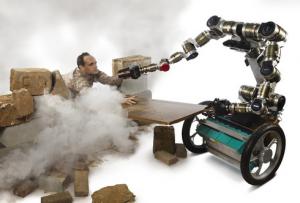EmergenciesIn emergencies, don’t trust a robot too much
In emergencies, people may trust robots too much for their own safety, a new study suggests. In a mock building fire, test subjects followed instructions from an “Emergency Guide Robot” even after the machine had proven itself unreliable — and after some participants were told that robot had broken down.

Simulation of rescue robot in operation // Source: gatech.edu
In emergencies, people may trust robots too much for their own safety, a new study suggests. In a mock building fire, test subjects followed instructions from an “Emergency Guide Robot” even after the machine had proven itself unreliable — and after some participants were told that robot had broken down. The research was designed to determine whether or not building occupants would trust a robot designed to help them evacuate a high-rise in case of fire or other emergency. Georgia Tech reports that the researchers were surprised to find that the test subjects followed the robot’s instructions – even when the machine’s behavior should not have inspired trust.
The research, believed to be the first to study human-robot trust in an emergency situation, is scheduled to be presented 9 March at the 2016 ACM/IEEE International Conference on Human-Robot Interaction (HRI 2016) in Christchurch, New Zealand.
“People seem to believe that these robotic systems know more about the world than they really do, and that they would never make mistakes or have any kind of fault,” said Alan Wagner, a senior research engineer in the Georgia Tech Research Institute (GTRI). “In our studies, test subjects followed the robot’s directions even to the point where it might have put them in danger had this been a real emergency.”
In the study, sponsored in part by the Air Force Office of Scientific Research (AFOSR), the researchers recruited a group of forty-two volunteers, most of them college students, and asked them to follow a brightly colored robot that had the words “Emergency Guide Robot” on its side. The robot led the study subjects to a conference room, where they were asked to complete a survey about robots and read an unrelated magazine article. The subjects were not told the true nature of the research project.
In some cases, the robot — which was controlled by a hidden researcher — led the volunteers into the wrong room and traveled around in a circle twice before entering the conference room. For several test subjects, the robot stopped moving, and an experimenter told the subjects that the robot had broken down. Once the subjects were in the conference room with the door closed, the hallway through which the participants had entered the building was filled with artificial smoke, which set off a smoke alarm.
